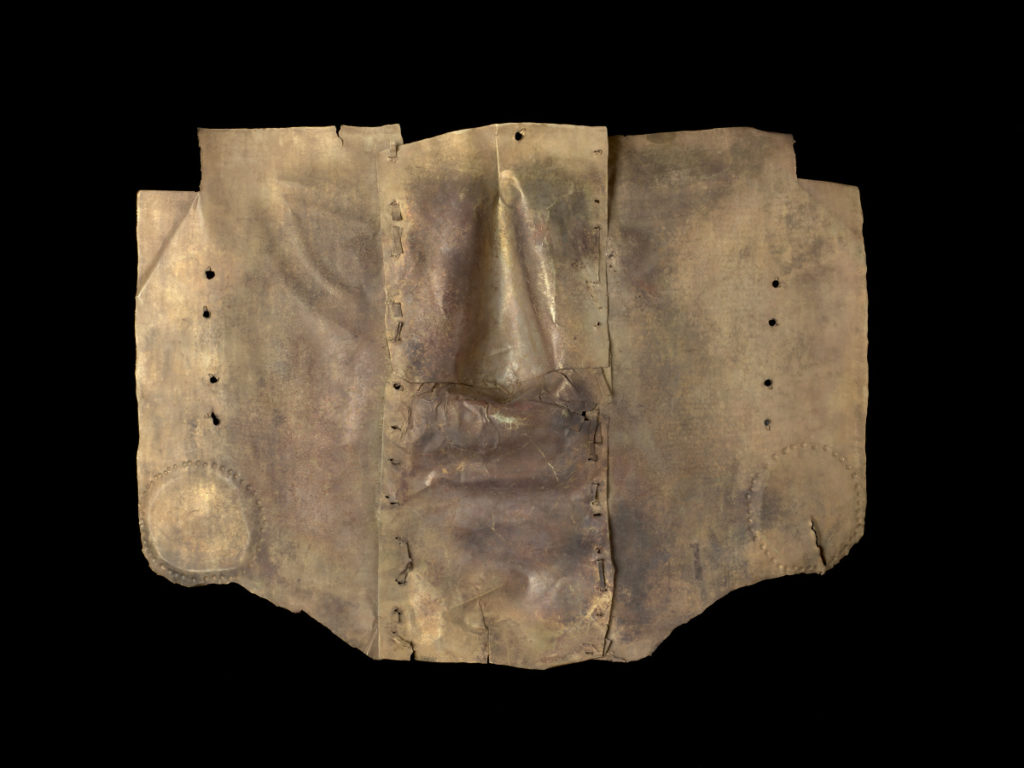Funerary Mask (work of art)
Artwork Info
About
Key Ideas
- This Sicán funerary mask is from the North Coast of Peru. It is made up of three sheets of hammered gold metal that are held together by tiny metal pieces similar to staples. A thin layer of red mineral covers most of the cheeks and forehead. The pupils of the eyes are round, blue-green beads, each with one small hole in the center. The details of the face include wing-shaped eyes, a three-dimensional nose and mouth, and two circular earpieces.
- The cheeks and forehead of the mask are decorated with cinnabar paint. Cinnabar is a rare and intensely red-colored mineral that contains mercury.
- The Sicán people lived along the North Coast of Peru from about 700 to 1370. The Sicán are also sometimes referred to as the Lambayeque (pronounced lam-ba-yeck-eh).
- Like the ancient Egyptians, the Sicán mummified the deceased. The mummies in Peru were meant to keep a physical representation of an individual’s status and power after they died.
Learn More
This funerary mask is made from a type of gold metal that was abundant to the Sicán people. The mask’s color indicates that it is an alloy, or mixture of metals. During the time in which the mask was made, the mixture of metals would have most likely been gold, silver, and copper. Artifacts of this kind were used to adorn the bodies of deceased rulers inside their burial places. The underside of the mask shows faint traces of the wrappings that once enveloped the mummy. The detailed facial painting indicates the high status of the individual who wore the mask. Mummification was used to preserve the power of a deceased individual. Scholars believe that funerary masks were created to help the deceased embody the power of the Sicán deities or divine rulers.
The cheeks and forehead of this mask were painted with a thin layer of cinnabar. Ancient Americans used cinnabar on sculptures and in murals. They also used it for important ceremonies and burials of individuals with high social status. Many cultures have used red pigments in their burial traditions. These pigments were used in graves, on bodies, and on burial masks. Sometimes human blood was even mixed with cinnabar to create a special paint. This red paint was applied directly to the body of the deceased.
The blue-green beads in the center of the eyes are most likely made of turquoise. Similar funerary masks, with the same type of eyes, have been found during archaeological excavations. The mask’s form is consistent with the Lambayeque (Sicán) style. It features upturned (wing-shaped) eyes, a prominent nose, a thin mouth, and round ornaments on the ears. There are two tiny holes in each side of the mask. They may have been punched into the metal in order to attach danglers.
Additional Resources
Resources for Teachers
- Visit a web page that includes facts about the Sicán people.
- See how mummy bundles were created in Peru and explore how they are similar to the mummy bundles found at Sicán archaeological sites.
- Read an article about the production and craftsmanship of metal pieces from the Sicán.
Resources for Students
- View a Sicán funerary mask from the Dallas Museum of Art.
- View another Sicán funerary mask from the Metropolitan Museum of Art.
- Watch a video about the systematic looting and robbing of Sicán artifacts.
- Explore a resource from the NCMA to learn more about cinnabar.


